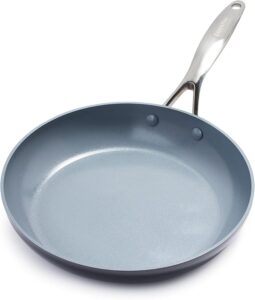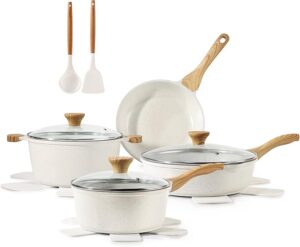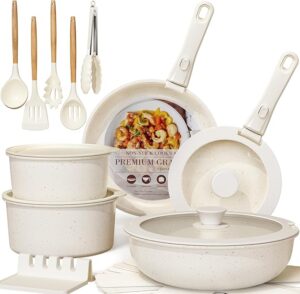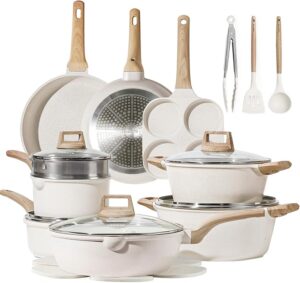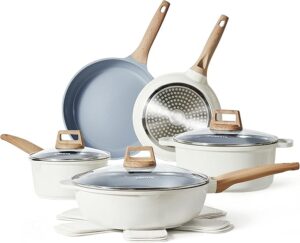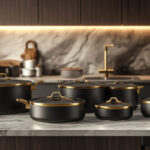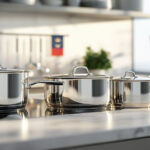Teflon vs Ceramic: Which Non-Stick Coating Is Better for Health and Durability?
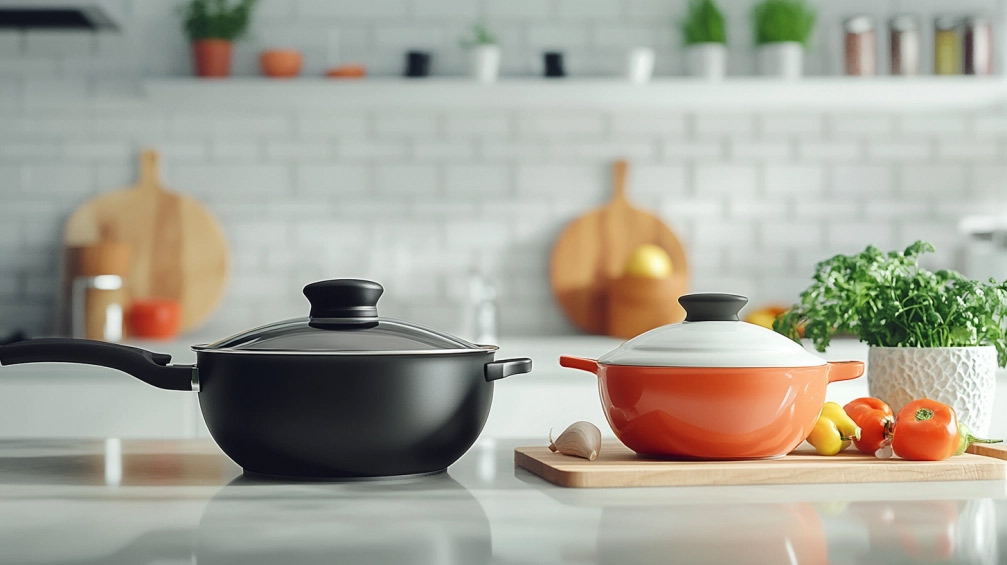
A wide variety of home cooks and culinary enthusiasts consider Teflon vs ceramic pans a necessary debate when it comes to the selection of non-stick cookware. While there are many options, the variation in health implications and durability significantly differ, so it is important to understand the differences in making an effective choice. Meanwhile, ceramic coatings are usually advertised as healthier and more environmentally friendly. Teflon has been in the kitchen for decades with its slick surface and ease of cooking. In this article, we look at some pros and cons of each non-stick coating regarding their safety profile, how long they last, and general performance in the kitchen to help you decide which option best fits your cooking needs.
Teflon’s History and Controversies: What Is PTFE?
Teflon is a brand name for polytetrafluoroethylene, better known as PTFE. Rather interestingly, it has made its history with cookware and became synonymous with the term non-stick coating. This polymer was discovered by a chemist named Roy Plunkett back in the 1930s. Because it was resistant to both heat and chemical reactions, the first applications of Teflon were quite industrial. It wasn’t until the 1960s that Teflon started to make its way onto cookware across America and began to change the world of cooking with its superior nonstick properties. On the other hand, while Teflon made life easier in the kitchen, its road has not been without its controversies over health and environmental matters.
The main active constituent of Teflon is PTFE, which works very well for its non-stick purpose but has since raised questions about its safety. Among the primary items of concern involves a process agent called PFOA, or perfluorooctanoic acid, used in a previous manufacturing process to make Teflon. Known to cause specific health concerns, including cancer and reproductive issues, PFOA has placed non-stick cookware under high scrutiny. Due to these concerns, PFOA has not been used in Teflon products since 2013, which means that the newer generation of Teflon-type non-stick coatings are much safer for consumers.
In the debate between Teflon vs. ceramic pans, safety controversies associated with Teflon-coated cookware have made many consumers consider alternative options. While these ceramic nonstick alternatives are often marketed as healthier and more environmentally friendly, they come with their set of pros and cons. Specifically, ceramic coatings are typically clear of toxic chemicals but give up the strengths of durability and heat resistance that PTFE can offer. Ultimately, the best nonstick coating for your kitchen involves weighing the health implications of Teflon against the performance and longevity of the ceramic alternatives. Understanding Teflon’s history and the controversies surrounding it is a vital component in making informed decisions about cookware as more and more consumers turn to supposedly safer cooking options.
The Health Benefits of Switching to Ceramic Non-Stick
You would come out going for the ceramic non-stick cookware when it came to health benefits, helping with cooking improvement and assuaging some apprehensions associated with more traditional non-stick coatings such as Teflon. Understanding the benefits of ceramic non-stick surfaces will assist in making a better choice for kitchens amidst debates on the best Teflon vs ceramic pans.
The main health advantages of ceramic non-stick cookware are the fact that, out of most other cookware available in the market, it does not contain hazardous chemicals such as PTFE and PFOA, which have posed a health threat in recent years. In stark contrast to Teflon-coated pans, which emit toxic fumes when they become too hot, ceramic coatings are made from natural materials and are considered much safer for daily use. This means one can confidently prepare one’s meals, knowing he or she reduces exposure to potentially harmful substances.
Besides, ceramic non-stick cookware allows a healthier way of preparation, given that less oil and fat can be used. Since ceramic pans have excellent non-stick properties, you are able to sauté, fry, or bake foods with very minimal added fats, which is helpful in the making of lower-calorie dishes without sacrificing flavor. This becomes helpful, especially for those people who wish to eat more healthily or who are on a weight-watching program. Also, even heating along the bottom of ceramic non-stick pans inhibits hot spots from forming. This allows food to be cooked evenly without burning, thus retaining more nutrients.
Finally, the durability and scratch resistance of good ceramic non-stick pans ensure long-term usability and reduce the chance of flaking or peeling, as older Teflon coatings did. This aspect makes ceramic pans not only healthier but also more viable for sustaining a healthy environment since these pans can take day-to-day use without breaking down overtime. While, to some degree, the coating of ceramic cookware is not as durable and long-lasting as Teflon, the health advantages derived from switching to ceramic create an attractive option for those seeking to cook more safely and healthily.
Which Lasts Longer? Comparing the Durability of Teflon and Ceramic
Durability, for many home cooks, is the main factor when choosing the best type of non-stick cookware. In fact, debates about Teflon versus ceramic pans usually revolve around which one of the two does better in terms of longevity and value. Both classes of cookware have their merits, but being more aware of their respective durability will help you choose well according to your needs and cooking style.
Teflon Pans: Durability and Lifespan
Teflon, popularly known as PTFE or polytetrafluoroethylene, has its application in non-stick pans for a long time. Some of the ideal benefits of the Teflon pan are great non-stick characteristics, which enhance food release and easy cleanup of the pan. However, there are various ways Teflon coating could be affected in terms of durability, such as usage and maintenance.
With proper care, a high-quality Teflon pan could last a couple of years. To make this possible, it requires that one does not use metal utensils, since the latter scratches the non-stick surface. Also, the coating tends to break down when cooking at high temperatures and loses its effectiveness in the process. Though the Teflon cookware manufactured in recent times does not contain PFOA anymore, chipping and peeling remain an issue if the pans are not well taken care of.
Ceramic Pans: Resilience and Wear Resistance
Ceramic non-stick cookware has become popular for use as an alternative to Teflon, generally publicized as being safer and even more ecological. Overall, ceramic coatings are made from natural components, without incorporating hazardous chemicals like PTFE and PFOA. As for durability, the ceramic pans can be much more resistant to high temperatures; thus, they are well-suited to different ways of cooking, including browning and sautéing.
Ceramic non-stick pans have excellent non-stick performance on the first day, but how well they will last depends much on the quality of the coating. Low-budget ceramic cookware may wear off faster, which means the non-stick properties will gradually deteriorate. Besides, the ceramic coatings can be quite chippy or cracky if not treated with good care. Gentle cleaning methods should be used without using metal scourers or abrasive sponges for maintenance of durability.
Which One Lasts Longer?
As far as the durability of the pans goes, Teflon vs. ceramic, several factors come into consideration. A fine-quality pan made of Teflon will serve a few years well, provided it is looked after, but it could be more sensitive to high heat and metal utensils. Ceramic pans can be resistant to higher temperatures of cooking and may show variation in longevity based on brand and care practices.
Which is better, then, Teflon or ceramic? Ultimately, it depends on your cooking habits and preferences. If you want ease of use and to save time cleaning, then Teflon might be a good option-if you take proper care of your pans. If, however, you are more concerned about the chemicals used in making Teflon pans and are willing to pay for higher-quality ceramic pans, then ceramic cookware is likely better concerning your health and safety.
So…
Both Teflon and ceramic non-stick cookware have their personal tussles when it comes to durability. By understanding their respective characteristics, you can make an even wiser choice that fits your culinary needs. The proper care and maintenance of both the Teflon and ceramic type will mean a lot in lengthening the life of your cookware and enabling you to enjoy cooking for years to come.
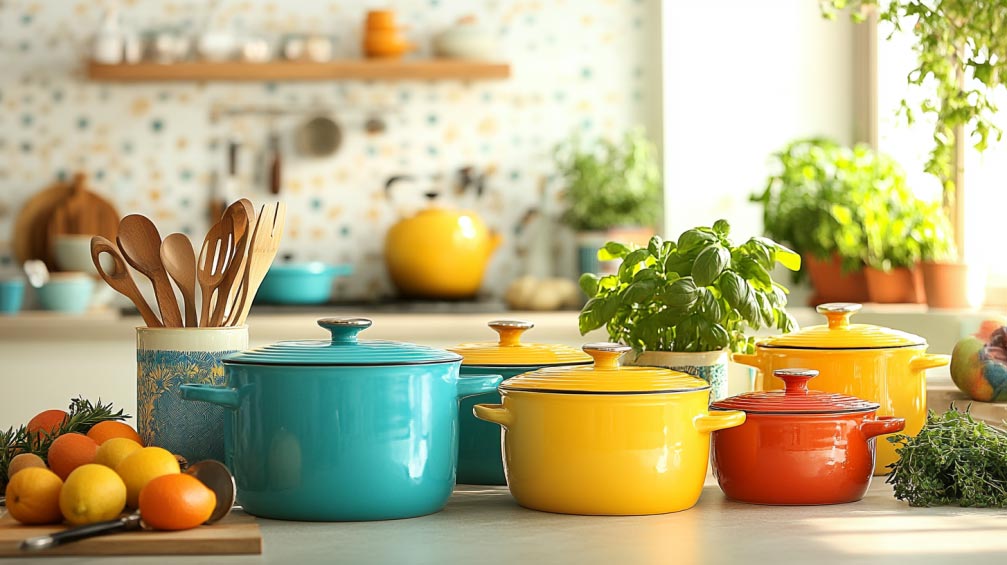
Cooking Efficiency: Do Ceramic Pans Heat Differently?
Amongst the choices of cookware, one frequently asked question is: do ceramic pans heat differently than the traditional non-stick options? Since ceramic non-stick cookware seems to be very popular lately, a little review of what you can expect from the heating aspect of such cookware will help in knowing how best to optimize cooking efficiency. As much as a ceramic pan offers many advantages, it has certain ceramic non-stick pros and cons that one ought to consider for the best cooking experience.
Heat Distribution and Retention
Among the other typical features of ceramic pans, one would mention evenly spread heat. Although some previous non-stick pan models can make hot spots, the ceramic ones tend to heat up considerably more evenly across their surface. That means the food will cook much more consistently and allow one to lower the risk of an unevenly cooked meal. This even heat will be more than welcome in sautéing or searing in general because it allows ingredients to brown well without burning.
On the whole, a ceramic pan could provide different properties in terms of heat retention compared to Teflon or other alternatives of non-stick cooking. Ceramic typically heats up very fast, hence enabling one to cook fast. It may, however, lose this heat faster once the heat source has been removed. That is, while ceramic pans are excellent for quick cooking tasks, taking care of the right temperature of cooking, especially in prolonged cooking sessions, may be more burdensome.
Cooking Times and Temperature Management
Another important thing is how ceramic pans interact with various cooking techniques. When working with this particular type of non-stick cookware made of ceramic, cooks often learn that they can work with lower heat settings and achieve similar results as higher heat settings when compared to traditional non-stick pans. This might, therefore, prove to be a plus for energy efficiency in the way of reducing total energy use during cooking. However, maybe this would vary depending on the quality of the ceramic coating gracing the pan.
As flexible as they are, ceramic pans tend to be a bit finicky with regards to extreme temperature changes. Adding cold ingredients to hot ceramic pans can cause thermal shock to the cookware, leading to cracking and chipping of the coating. Because of this, you should always heat your ceramic cookware gradually and add ingredients at a regular temperature so that it maintains its integrity and performance.
The Verdict: Are Ceramic Pans Efficient?
Simply put, ceramic pans can differ in heating compared to regular non-stick alternatives. They are available with different advantages and considerations. While their even heat can provide higher cooking efficiency, their response to temperature changes requires attention for optimal results. It is now time to consider the pros and cons that will establish whether ceramic non-stick is suitable for particular methods of cooking. Ceramic pans have several options for making them an even healthier, chemical-free alternative to traditional non-stick cookware in a manner that incorporates better techniques in their use.
Eventually, it’s up to personal preference and your particular cooking style. Once you know how ceramic pans take heat and generally act in the kitchen, you will be cooking efficiently and with great confidence, enjoying every meal.
Price Comparison: Are Ceramic Pans More Expensive Than Teflon?
Price is often one of the biggest factors regarding investing in cookware. For a home cook, determining the difference in price between Teflon vs. ceramic pans will identify which is the better value for their cooking use. While both have their benefits, the price can range from brand, quality, and features.
The Cost of Teflon Cookware
Teflon pans are as easily available as they are varied in cost. The general rule is that low-end Teflon cookware is rather inexpensive, hence more accessible to the resource-poor consumer. One can easily see basic Teflon frying pans and saucepans that sell for as low as $20 to $40. Those of mid-range, which incidentally show improved non-stick properties and good construction, usually go for $40 to $80. High-end Teflon cookware with advanced technology and added durability may exceed $100.
Although they are cheap, it is important to note that the cheaper alternatives for Teflon do not last longer compared to high-end pans. For the reputation of Teflon in its non-stick capabilities, the coating may wear out after some time, especially if the pans are not taken care of as they ought to be. It means that you will need to replace the low-priced Teflon cookware after a while, which increases the overall cost of getting your money’s worth.
The Cost of Ceramic Cookware
Speaking of prices, ceramic pans seem to fit into a higher category than Teflon ones. Though there are also quite cheap ceramic variants, high-quality ceramic cookware starts at about $30, while really good, well-known brands can cost $100 and more. The price for ceramic cookware regards not only the materials themselves but also the tech and manufacturing process of creating the non-stick coating, which is often promoted as much safer and eco-friendlier than traditional Teflon.
While the purchase price for ceramic pans may be a bit more in cost, durability and resistance to heat could, in fact be well worth it for some consumers. However, the durability of ceramic cookware will most definitely depend on the brand and how well the pans are taken care of. A high-quality pan outlives the cheaper Teflon alternatives, possibly being more affordable because it saves you from needing to replace them sooner.
Conclusion: Value Beyond Price
In short, in the debate of Teflon vs ceramic pans, the price seems to be but one of the issues. While Teflon cookware might be somewhat more budget-friendly upfront, you might receive shorter life spans with Teflon, resulting in higher costs over time once you have to replace pans more often. On the other hand, though ceramic cookware leans toward being more expensive upfront, its durability and health-conscious reputation can justify the investment for many cooks.
Ultimately, it would depend on one’s cooking style, whether higher or lower spending limits are involved, and, of course, personal preference. That may mean Teflon or ceramic cookware, but one needs to know whether what it takes to buy it is worthy of how long it will be able to last and perform. Such a decision will provide quality cookware that meets the needs of every kitchen while not necessarily breaking the wallet.


